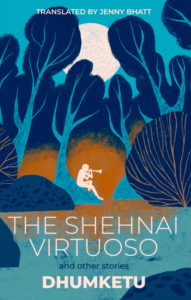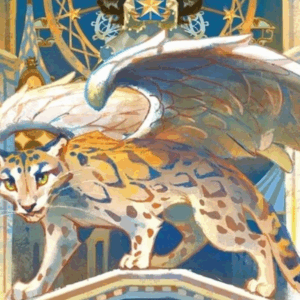
Breaking Down the Translation Pyramid: On Translating Dhumketu’s Pioneering Short Stories from Gujarati
Jenny Bhatt Considers Gujarati Literary Culture and the Politics of Translation
Dhumketu (1892-1965), one of the towering figures of Gujarati literature, often described the short story form as an incomparable flower in the garden of literature, as delicate as the juhi, as exquisitely beautiful as a golden bird, as electrifying as a bolt of lightning. For him, the short story roused the imagination and emotions by saying what it must through only allusions or sparks. This last idea was so important to him that he titled his first collection Tankha, meaning “sparks.” Later, he released three more story collections with the same title.
To accomplish so much through allusions or sparks, writers need more than imaginative invention. What’s indispensable is a deeply insightful observance of one’s world with a superior technical skill for capturing hidden, nuanced, and unusual details. Stefan Zweig once wrote about Tolstoy: “One who sees so much and so well does not need to invent; one who observes imaginatively does not need to create imagination.” This is also a perfect description of Dhumketu’s art and craft.
Had this writer been more widely translated and read, his stature and skill as a pioneer of the literary short story form in Gujarati would have been acknowledged as equal to that of Tolstoy, Chekhov, Tagore, and Premchand in their respective cultures and languages. Perhaps this translated volume of some of Dhumketu’s finest short stories will go some distance towards building that reputation.
The Evolution of the Gujarati Short Story
The short story form has existed for a long time across the Indian subcontinent. Though not formally identified as such, our ancient mythological and religious texts have always been a series of short stories woven together into long multilayered epics. That most of these were written in verse form rather than prose means that they continue to be technically recognized as mostly poetry.
The modern Gujarati short story owes a lot more to the European, Russian, and American short story of the nineteenth and early twentieth centuries than to those ancient epics. Much of Indian literature across all regions was being influenced by or adapted from works from Europe, Russia, and America during that time. However, for a long time, both prose and verse forms of Gujarati literature were dominated by themes of religion or nationalism. Before Dhumketu, writers like Dalpatram, Narmad (widely considered the founder of modern Gujarati literature), and a few others had studied Western literature closely to aid their own craft. Still, the short works that were written during their time were mostly fable or folktale like, or satirical, with the primary goal of enabling sociopolitical change or providing simple entertainment.
A major milestone was achieved when Bhogindra Divetia translated Tolstoy’s short stories into Gujarati. This set off a wave of more literary translations into Gujarati from other cultures and languages, including Bengali, Hindi, and Urdu. Along with this new exposure, there were even essays in major magazines and periodicals about the form’s literary merits and techniques.
This led to an enlightened appreciation of the short story as an independent literary form and several Gujarati writers began approaching it with more concerted efforts. As a result, this era also saw many short stories adapted from popular Western ones by writers like Maxim Gorky, Guy de Maupassant, Nathaniel Hawthorne, Edgar Allan Poe, O. Henry, and others. However, given the political climate at the time, the works continued to favor instruction and didacticism at the expense of aesthetics and craft.
Eventually, due to the works of stalwarts like Ranjitram Mehta, Dhansukhlal Mehta, and K.M. Munshi, the Gujarati short story came into its own as a literary art form. In 1918, Malayanil (pen name of Kanchanlal Vasudev Mehta) was credited with having written the first modern Gujarati short story, ‘Govalani’, which showcased all the classic elements of the form at the time.
This pre Dhumketu evolution of the Gujarati short story was predominantly characterized by translations from and adaptations of Western short stories. Original creations were somewhat uneven in their craft and technique, and biased towards easy entertainment or heavy-handed morality.
Dhumketu’s Pioneering Short Stories
Dhumketu was born as Gaurishankar Govardhanram Joshi in 1892 to a Brahmin family in Gujarat. In his memoirs, The Path of Life (Jivanpanth) and The Colour of Life (Jivanrang), he writes about how stories came to flow in his blood from an early age: through the oral storytelling of his parents and his own fascination with the lives of historical figures. As was common for most Gujarati writers of his time, he was heavily influenced by Narmad’s heroic tales, the ancient epics of Vyas and Valmiki, and the innumerable Gujarati folk tales passed down orally from generation to generation.
Throughout his schooling, his years studying Sanskrit and literature at university, and his career as a schoolteacher, Dhumketu had access to many literary works, especially through the private libraries of certain wealthy patrons and educational institutions. Early in his teaching career, he was assigned the task of reading biographies and historical novels to a nobleman’s wife—an activity that fed both his reading habit and writing aspirations. While teaching at a private Ahmedabad school—owned by Vikram Sarabhai’s father, Ambalal Sarabhai—he gained an even wider exposure to all forms of art and culture including music, drama, sculpture, and poetry.
He started writing while still in middle school and gained a reputation as an essayist and poet. While studying for his matriculation, he used a couple of different nom de plumes like “Vihaar” (sport) and “Paagal” (crazy). The adoption of “Dhumketu,” meaning comet, came later during his university years of trying and failing (initially) to get his early short stories published.
Considered one of the pioneers of the Gujarati short story, Dhumketu wrote more than 500, collected in twenty-four volumes. These were accompanied by twenty-nine historical novels, seven social novels, numerous plays, travelogues, essays, literary criticism, and memoirs. There were also careful, painstaking translations of writers and poets like Kahlil Gibran, Rabindranath Tagore, and others.
His most well-known and frequently anthologized short story in English translation is “The Post Office.” An early version was published in 1923 and, while it is not his best in terms of technique and craft, it still appeals to a wide readership in terms of age, geography, and culture because of its simplicity and pathos. A lonely old man waits, in vain, for his daughter’s letter. Through this one circumstance drawn on an intimate canvas, Dhumketu gives us the universal: a father’s longing for a lost daughter’s love and the world’s indifference to, even derision of, such a deeply personal need.
The first collection, Tankha I, followed in 1926. Using all the variegated raw materials from the short stories before him—craft techniques, social issues, prose styles, themes, exposition approaches—Dhumketu took full advantage of the readers’ cultivated fondness for the short story form to offer many skilful original and adapted creations. So much so that his name became synonymous with short stories in Gujarati literary culture.
His work was notable then, as it is even now, for three standout aspects. These set him apart from his major contemporaries—K.M. Munshi and Jhaverchand Meghani—in Gujarati literature at the time. While the other two, like many other prominent writers of their time, were also on the frontlines of India’s social reformation movements and its fight for freedom from the British, Dhumketu chose to allow his writing to do all the speaking. In his story, “The Creator of Life’s Ruins,” he illustrates this belief: “Someone has said correctly that society is shaped by individuals. But an individual is shaped by work.”
The first differentiating aspect was how he explored the inner worlds of his characters through their experience of external events. To that end, the events portrayed in Dhumketu’s stories were much more than a sequentially linked chain. They were a means to illustrate deeper nuances of human nature and evoke particular emotions and ideas within his readers. Plot, character, action, setting, dialogue, theme—all of these were employed to make his readers live within those characters’ inner worlds.
Before India achieved independence, Dhumketu deviated from the norm in ways that make his stories even more relevant during our times.
The second important divergence from the short stories of his time was his focus on people from all walks of life—rural to royal, young to old. Frequently, his characters were from the lower classes and castes—a section that had been largely neglected or caricatured in Gujarati literature until then. Dhumketu’s depictions of village and family life were not as influenced by Gandhi’s teachings and exhortations of moral and humble grassroots living as were those of his contemporaries.
And, while Dhumketu certainly explored the familiar themes of sacrifice, love, individualism, and patriotism in both his social and historical fiction, he often preferred to do so through the lives, joys, and sorrows of commoners. One of his deeply held beliefs, mentioned variously and often throughout his works, was as follows (quoted from “The Noble Daughters-in-law”): “That a man is a king only due to the circumstances of birth should be considered just as terrible as when a man is untouchable only due to the accident of his birth.”
The third exceptional characteristic of Dhumketu’s works was how his strong, independent-minded women and emotionally sensitive men were well ahead of their time. Before India achieved independence, when nationalistic and religious fervor called for traditional gender roles in not just the real world but also in those created by artists, Dhumketu deviated from the norm in ways that make his stories even more relevant during our times.
The Selected Stories in This Collection
To choose a “best of” selection from a writer’s works when the oeuvre is as wide-ranging and vast as Dhumketu’s is an impossible project. Beyond the question of how “best” should be defined, we have the typical dilemma faced by all writers or translators of story collections or anthologies: of trying to make every story appeal to every reader.
For this project, I wanted to ensure the following: enable an understanding of Dhumketu’s chronological progression as a short story writer; showcase his range and skills with different themes and styles; whet the reader’s appetite for more of his works.
So it made sense to select at least one significant story from each of the twenty-four published volumes. There are two additional stories here: the most anthologised “The Post Office,” which was included as it is the most recognized of his works; and “Kailas,” which can only be justified as this translator’s whimsy because of a personal connection. That both stories feature aged fathers grieving the absence of a child is an interesting coincidence but, given Dhumketu’s own life, not entirely a surprising writerly preoccupation.
Two stories, “The Dispenser of Justice” and “The Worst of the Worst,” have the same main plot point: a poor man is wronged by a powerful, rich one. However, while one is about exacting revenge, the other is about extracting justice. Most importantly, the two stories are different in narrative voice, point of view, and literary style, and highlight something that many short story writers do even today: adapt their own works to revisit certain themes or issues they feel compelled to re-present to their readers.
As a translator and a short story writer myself, I was keen to unpack the nuances and layers of these two similar stories to understand why Dhumketu was compelled to revisit them with different narrative voices, points of view, and styles. As a literary critic, I was driven to comparative criticism to understand how the writer worked at honing both his craft and his message with these two stories. As a reader, I was curious to see how a man went from considering revenge as a way to restore balance in one story to showing how justice is the way to right a wrong. That journey—from vindictiveness to vindication, emotionality to rationality, personal to impersonal, resolution to closure, and retaliation to righteousness—could not have been easy as it involved switching from the low road to the high road.
Only one of the short stories in this collection is historical while all the other selections center on sociocultural issues, several of which prevail in Gujarati society even today. “Tears of the Soul” is based on the story of Amrapali, the royal courtesan of the ancient kingdom of Vaishali (present-day Bihar). As with all of Dhumketu’s historical works, this story is well-researched for accurate period details (with a number of authorial footnotes) and fictionalized like a theatrical drama. In keeping with the “variations on a theme” approach mentioned earlier, Dhumketu wrote this short story about Amrapali and then went on to write an entire novel about her.
A majority of the stories are set in rural Gujarat, which Dhumketu felt was underrepresented in Gujarati literature of the time. And a number of them are set in India’s northeast rather than Gujarat. These showcase not only how Dhumketu’s wanderlust and creativity fed off each other, but also his fascination with and close observation of the cultures of other regions.
While more stories here have male protagonists, it is the women protagonists who are more singularly memorable. Dhumketu was certainly not free of the gender biases of his time; however, he took care to portray his female protagonists as complex human beings in their own right. He also did not hesitate to poke fun at the classist pomposities and self-inflicted pain of the male characters, who were often based on his own professions: teacher, writer, poet, government employee, etc.
A literary translation like this collection seeks to be a mode of recovery and reclamation. It hopes to be a disruptive intervention in cultural discourse. Most of all, it aspires to be a glorious revival of diverse, almost-lost literary traditions.
In his literary criticism, Dhumketu often mentioned that the real beauty of the Gujarati language had barely been revealed by the literary works of his era. His narrative style was in the somewhat effusive, romantic tradition of his time. From his essays, memoirs, travelogues, and his own introductions to his story collections, it is evident that he was more influenced—in terms of technique and style—by Western, European, and Russian short story writers (Tolstoy, Gorky, Chekhov, Maupassant, Hawthorne, Kipling, to name a few) than his Gujarati predecessors or contemporaries. As a literary translator himself, he favored poetic aphorisms like those of Kahlil Gibran and lyrical prose like that of Rabindranath Tagore. That said, his stories are tautly structured and intricately detailed. There is very little superfluity in his exposition.
Overall, it is possible that the contemporary reader might find stereotypical and caricatural depictions in some of these works. However, we must acknowledge that we have the benefit of hindsight about our past societies while Dhumketu had the unavoidable biases and prejudices of a middle-class man of his time. This is not to excuse the writer’s judgment flaws but to acknowledge them as part of the man’s sociocultural limitations.
Why It Has Taken So Long to Bring Dhumketu to an English Readership
India has at least 121 languages and hundreds of “mother tongues.” European colonization had exacerbated language politics and biases, which have continued to this day. Mahatma Gandhi’s pre-Independence push to standardize one Gujarati dialect as the acceptable one for education, business, and government communication resulted in even more hierarchies.
All of the above has created what’s called the translation pyramid, where literature from certain languages gets translated more (and, hence, is more accessible, visible, and dominant): Bangla, Hindi, Urdu, Tamil, to name a few. Probe further and you’ll find that’s because there are more bilingual and multilingual translators and readers in those languages than others, which makes them more “marketable” to publishers.
Dig even deeper for why those languages have more translators and readers and you’ll unearth age-old regional complexities related to education, class, and caste systems. There are underlying misconceptions as to which languages are considered “pure” versus “corrupt” or “derivative.” There are strong opinions about which languages have rich written literary traditions (when so many of our languages still have oral traditions that need to be captured before they’re lost forever.) Never mind translations into English, these cultural politics exist even for translations into designated filter languages.
So, despite the Gujarati language being the sixth most spoken in India and the third most spoken among the South Asian American diaspora, its literature has not been translated as much as some other languages. This has relegated a writer of Dhumketu’s stature and talent to near-obscurity so that even subsequent generations of Gujarati readers and speakers have barely any awareness of his works.
Therefore, a literary translation like this collection seeks to be a mode of recovery and reclamation. It hopes to be a disruptive intervention in cultural discourse. Most of all, it aspires to be a glorious revival of diverse, almost-lost literary traditions such that, if transplanted with care and attention, they might bear rich, new fruit.
________________________________

From the translator’s introduction to The Shehnai Virtuoso and Other Stories by Dhumketu, translated by Jenny Bhatt, published by Deep Vellum. Introduction copyright © 2022 by Jenny Bhatt.
Jenny Bhatt
Jenny Bhatt is a writer, literary translator, and book critic. She is the founder of Desi Books, a global forum that showcases South Asian literature from the world over. And she teaches creative writing at Writing Workshops Dallas and the PEN America Emerging Voices Fellowship Program. Her 2020 story collection, Each of Us Killers: Stories, won a 2020 Foreword INDIES award in the Short Stories category and was a finalist in the Multicultural Adult Fiction category. Her 2020 literary translation, Ratno Dholi: Dhumketu’s Best Short Stories, was shortlisted for the 2021 PFC-VoW Book Awards for English Translation from Regional Languages. One of her short stories was included in The Best American Mystery and Suspense 2021. Her nonfiction has been published in various venues including NPR, The Washington Post, BBC Culture, The Atlantic, Publishers Weekly, Dallas Morning News, Literary Hub, Poets & Writers, Los Angeles Review of Books, The Star Tribune, and more. The US version of her Dhumketu translation, The Shehnai Virtuoso and Other Stories, will be out in July 2022. Find her at https://jennybhattwriter.com. Sign up for her popular, free, weekly newsletter, We Are All Translators.












